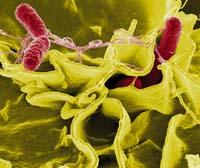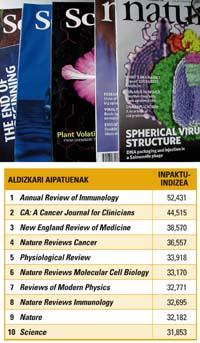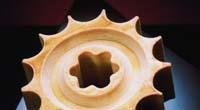Publish or die
2006/09/01 Rementeria Argote, Nagore - Elhuyar Zientziaren Komunikazioa Iturria: Elhuyar aldizkaria

However, since it is thought, the main reason for the publication of the articles is that, but they are also eleven reasons. In fact, the reputation of a researcher grows as articles are published, especially in prestigious journals. And when it comes to obtaining grants to continue investigating, it also helps to have a long list of articles in the researcher's curriculum.
In search of prestige
As the research is done it is important to publish articles. And so important is where it is published. The publication itself in a prestigious magazine is news in the media, which in turn increases the fame of the writer.

In this world of publications the lists are very common: the researchers who publish the most, the authors of the most cited articles, the most consulted articles, the journals with the most readers, etc.
Many of these lists are prepared with references in mind. In fact, the end of the article refers to several articles and authors. They cite those related to the research that is made known, those consulted and, in general, those that have helped the author. Data from these mentions are collected and very diverse estimates are made to draw conclusions. It is, in short, a kind of continuous market study.
These are the teachers of the Thomson Corporation in the collection of data and elaboration of these lists. For example, the list of leading researchers from 2004 and 2005 has been compiled. The head of the list is a researcher at Osaka University: The Japanese Shizuo Akira. He works in the field of immunology, and the articles he wrote in the previous two years (or signed together with other authors) are on the list of the eleven most cited (known as hot papers).
Another example. The most prominent writer of the 1980s was Robert Gallo, an AIDS discoverer. He signed 591 articles and received 36,000 references in other articles. On the other hand, the article that has received the most references is the one related to the characterization of proteins. It was written by Lowry, Rosebrough, Far and Randall in 1951, with more than 245,000 mentions.

Stronger magazines
In this sense, the list of journals with more mentions has become very important. It must be taken into account, since, on the one hand, most researchers want to publish in these journals, which allows choosing the best articles of the journal that appears in this list and, on the other hand, the great dissemination of this journal makes the articles reach the hands of more researchers and therefore have more references. It is a circle in which it is not easy to enter.
There are several ways to make lists of the most cited journals. The easiest thing is to count the references to the articles of a particular journal. But journals that publish more articles have an advantage. Therefore, the impact index is increased. The impact index shows the number of citations a journal has received in other journals in the last two years, but taking into account the total number of published articles.

The impact index of the journal Science is, for example, 31.8. That is, an article published in this journal contains an average of 31.8 mentions in the two years following its publication. This is a very high impact index: Science ranks ninth in the list of the most cited journals.
In the ranking are the magazines that publish articles of collection, the so-called review. The magazine that receives the most comments is, for example, Annual Review of Immunology. It is not surprising that the collection articles collect the most mentions: each article is usually a kind of summary on a topic, so they are very useful to collect information on a research topic without having to look here or there. For in the first ten are magazines of six articles of collection.
In the first ten, Nature and Science will be known to street people. It occupies ninth and tenth place, respectively.
From this list of journals you can make another reading: the areas that are currently at the top are those related to Biochemistry and Medicine. The journals that receive the most comments are, at least, from those areas. Therefore, the scientific field is also important when publishing it.
In this way, the impact index can also be used to compare research areas. As already mentioned, the highest index has a collection of Immunology, 52.4, since none of the journals of Polymer Sciences reaches 10. One of the best-known journals is Macromolecules, with an impact index of 3.9. The difference is remarkable.

Looking to measure quality
Are journals with the highest impact rate the best in quality? It is not easy to answer this question. And it is not even possible to put quality in figures. However, it is clear that the impact index is not enough to measure the quality of a journal.
The implementation of online journals has made progress in this regard. This support offers other possibilities to measure the prestige of a magazine. For example, the number of links a website has to other pages is counted and, conversely, how many links there are from other pages to that website. The latter allows measuring the quality of information.
However, experts in the field are best suited to measure the quality of a specialized article or magazine. The inventor of the impact index, Eugene Garfield, has been a master in the use of data on articles, and has proposed that the impact index should add comments and expert opinions to distinguish between 'popular' journals and elites, for example.

And there are magazines that are popular, that is, they reach many people, but they do not have very good reputation among experts; and on the contrary, there are very high quality magazines that reach few people because they are elite. The key to success would probably be in the balance of both variables.
Peer review: Research staff
The publication of a quality journal requires the participation of experts, not only to assess the result, but also to ensure the quality of the articles before publication. Editors of specialized journals have long seen the need for experts to validate an article. And so a system called peer review was launched.
It can be said that scientists have shown their work almost always asking other scientists for feedback, always informally. It has been a regular activity. But this action is systematized when publishing it. When a researcher writes an article and sends it to a journal, before publication the article passes to other researchers to judge whether it proceeds and make appropriate corrections, if necessary.

The author of the article does not know who will judge his work and, on the contrary, the judges do not know the article in their hands. The system is completely anonymous.
This system encourages science to a certain extent, since the author receives observations on the research described in the article, which allows improving research. However, not all articles come into the hands of these judges. There are many articles that reach the journals (especially the most prestigious ones) and the editor has to use the sieve; many articles are rejected directly by himself, because they are not appropriate for this journal.
Another problem with this system is that the work of the judge is increasingly complicated: they have less time to read the article and say -- not more than a month -- and lately they are very pressured, for example, when fraud occurs they feel responsible. And keep in mind that at the same time they investigate and prepare articles to publicize their work. In addition, judicial work is done free of charge.

As you can see, it is not a perfect system, but for most researchers it is the best invented so far. This system has been tried to change, but in essence the system of article prosecution has changed little in recent decades. News can come from the Internet. In fact, online magazines are gaining strength. There are people who are born from the traditional model, who are versions of a paper magazine, but there are also completely electronic magazines that do not control the editorials, and by that way I do not know what will come in the future. Let whatever comes, let it be for good.
Thanks to José Ramón Leizari, from the Faculty of Chemistry of the University of the Basque Country, for his collaboration in the preparation of the article.







